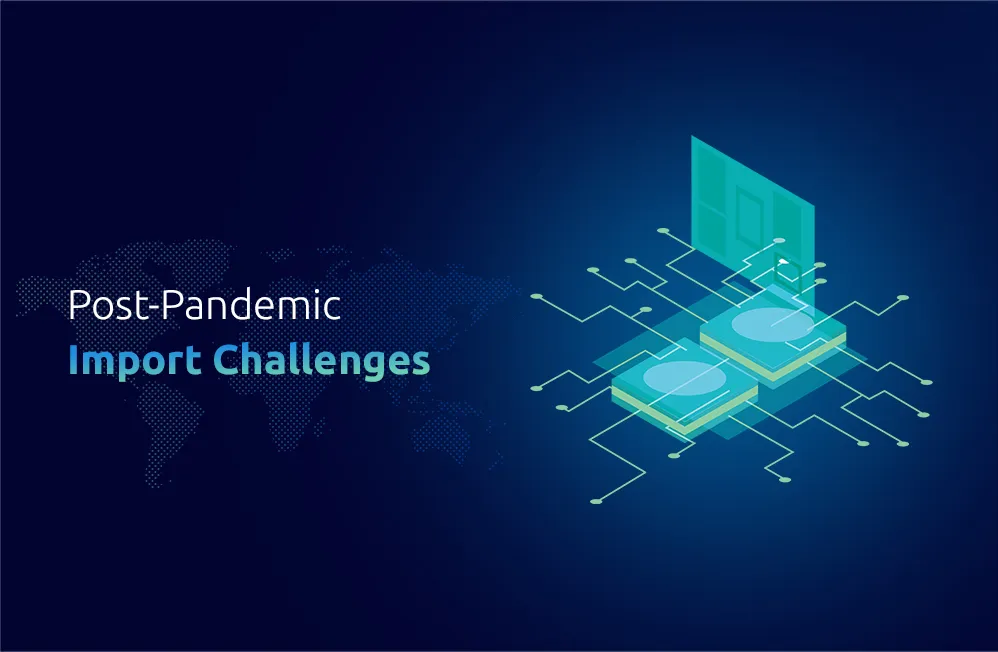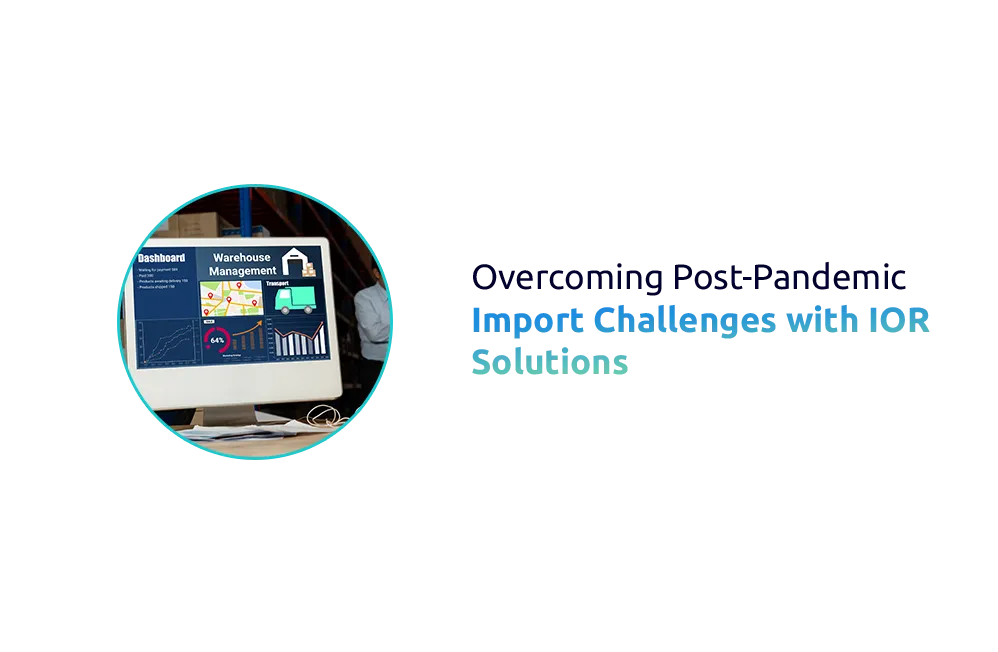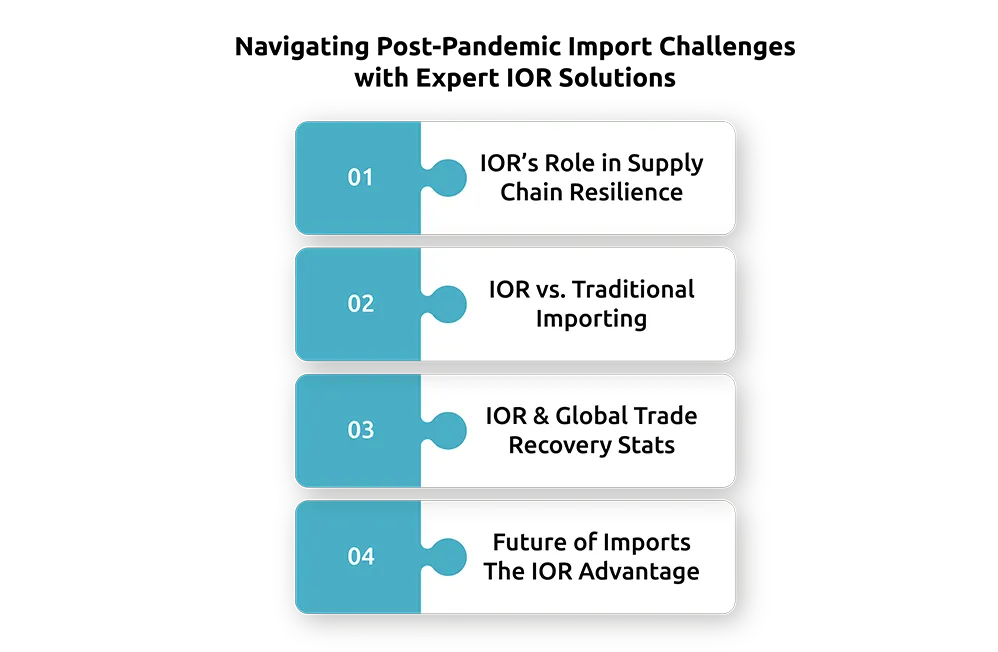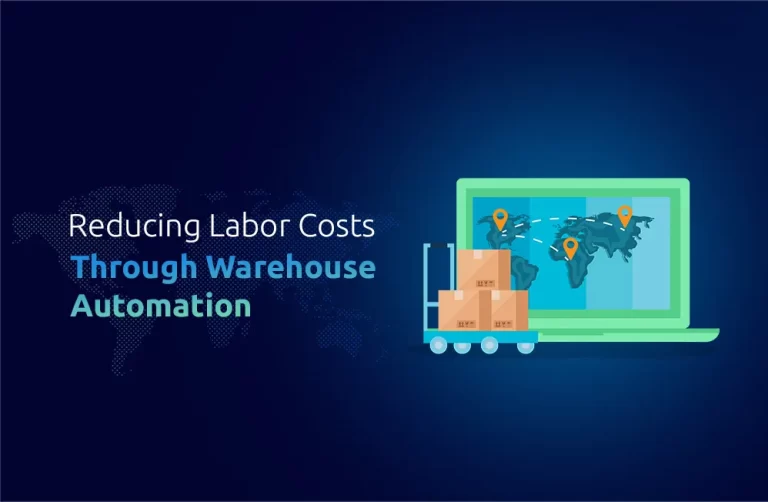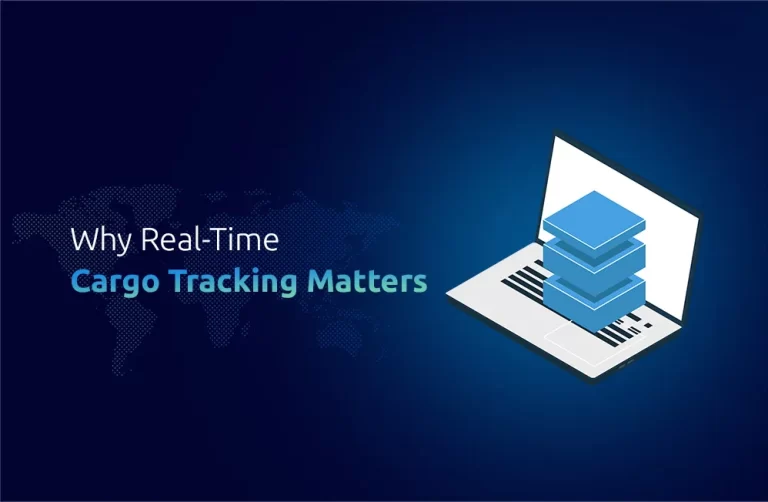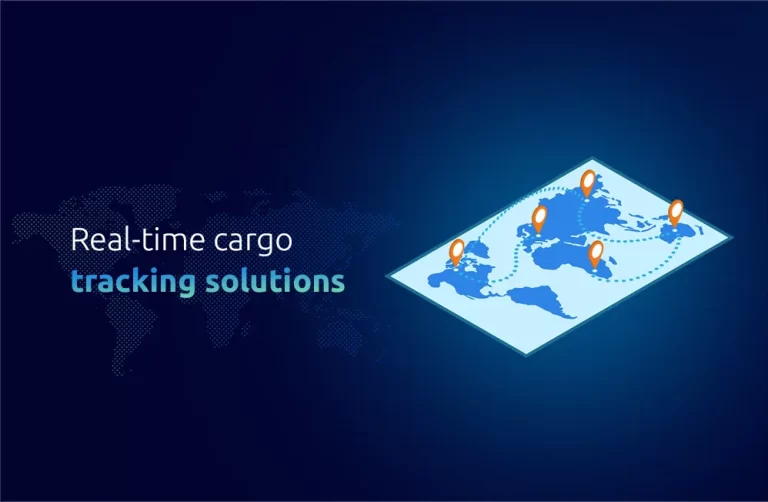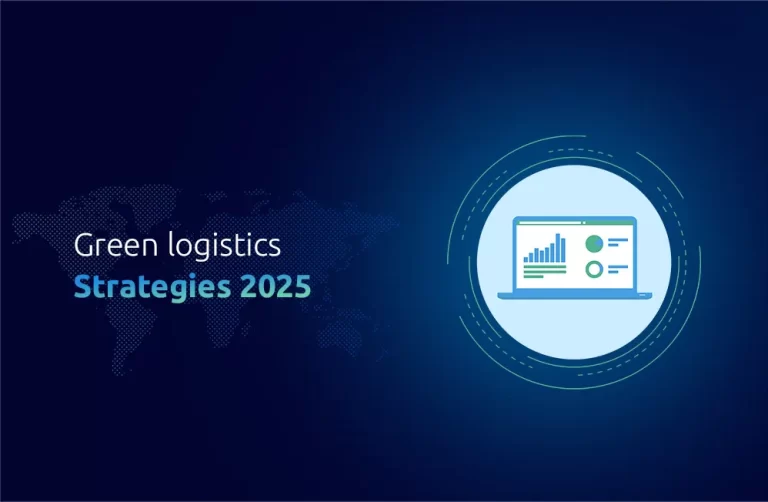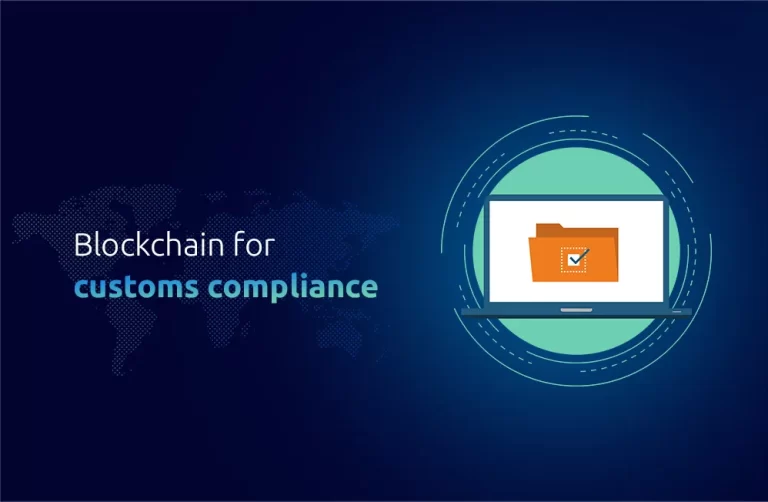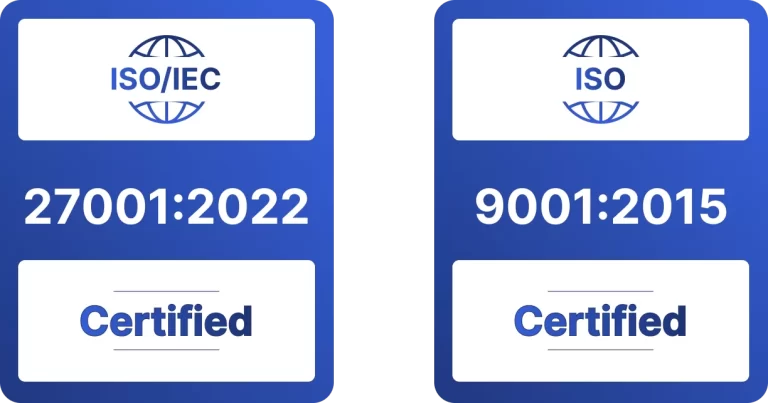The Challenges & Opportunities | Importing in a Post-Pandemic World
COVID-19 resulted in lasting modifications to business import systems because the worldwide supply networks encountered extensive disruptions. Global trade has grown more complex because shipping delays, higher costs, and regulatory transformations have been widespread. Business recovery combines with new norm adjustments, which force organizations to focus intensely on importing sensitive high-value goods. IOR experts have proven essential for companies managing risks during current market instability. The article examines the current challenges of importing goods after the pandemic while explaining how IOR services provide solutions to optimize operations. The analysis will examine logistics, tariffs, and regulatory changes while discussing technology’s role in reducing supply chain interruptions.
In the post-pandemic era, import challenges have become more difficult due to ongoing global (inurl:post) disruptions, such as increased shipping costs, regulatory fluctuations, and warehousing shortages. These problem have highlighted the requirement for strong supply chain solutions for import challenges, especially when managing valuable or sensitive goods. Organizations now depend hugely on digital tools, live tracking systems, and experienced Importer of Record (IOR) services to guide the shifting landscape. By combining technology and strategic partnerships, businesses can overcome modern import disruptions and ensure compliance, efficiency, and resilience across their global operations.
The Current Landscape of Global Trade
Global trade operated with steady logistics systems, clear regulatory guidelines, and predictable shipping timelines before the pandemic began. The pandemic caused worldwide disruptions to ports and its consequences on shipping lines and regulatory agencies around the globe. Many top importer nations faced problems while managing their ports, including transportation delays, inadequate storage facilities, and enhanced demand for shipping services.
The pandemic exposed supply chain vulnerabilities even within advanced systems because freight forwarding and cargo freight forwarders support global transportation. Ports alongside warehouses remain behind schedule with massive backlogs, while unrelated fees, especially demurrage fees, and unexpected drayage charges, complicate the situation.
Challenges in Importing in a Post-Pandemic World
The importation of goods, especially high-tech equipment and sensitive materials has been plagued with several
challenges post-pandemic. Below are some of the key hurdles businesses face:
1. Increased Shipping Costs and Delays
International trade logistics now comes with both higher costs and unpredictability. The pandemic produced extensive delays and shipping route impediments, leading several ports to face extreme congestion and delayed operations. Extended delivery delays, together with increased port expenses, led to higher costs for shipping fees, including the penalties for unacceptable pick-up times and port-to-warehouse transport expenses.
2. Tariff and Regulatory Changes
The pandemic has caused countries to reconsider their economic plans through which business-related trade tariffs have shifted unpredictably. Businesses need to maintain current awareness of the latest updates regarding regulations and compliance since failure to do so can lead to penalties. The ECCN and product HS code classification have become extremely essential for businesses.
3. Warehouse and Supply Chain Shortages
The ongoing high demand for goods puts severe pressure on the supply chain management sector through decreasing warehouse availability. Supply chain costs increase as warehousing rates increase and product distribution requires additional time while the logistics expenses escalate. The insufficient number of available warehouses negatively affects the proper management of 3-phase power supplies, which are crucial for storing equipment, particularly medical equipment and information technology systems.
4. Lack of Visibility and Transparency
The continuous movement of global trade creates difficulties for businesses in tracking their shipment locations effectively. Companies face decision-making challenges because they lack precise knowledge about their supply chain products. Better transparency in air freight estimating relies on the air freight calculator and advanced analytics tools despite ongoing shipping cost unpredictability.
Opportunities Arising in the Post-Pandemic World
The pandemic has proved problematic for organizations yet presents fresh business opportunities for firms that take adaptive measures. The following actions will help businesses maximize benefits from the new post-pandemic trading conditions:
1. Adoption of Technology
Global trade underwent significant changes with the help of technology after the pandemic unfolded. Businesses achieve easier shipment tracking and management through digital platforms that appeared with the growing technological landscape. Businesses can minimize import uncertainties through real-time supply chain management systems that monitor goods and automate customs processing.
2. Enhanced Regulatory Compliance Tools
The new pandemic environment requires businesses to work with experienced importer of record services, which will increase their regulatory compliance capabilities. Professional importer of record services fulfil every regulatory requirement to protect businesses from regulatory penalties and expensive delays. After the pandemic began, many companies depended on HTS harmonized tariff codes to support mandatory tariff classifications.
3. Sustainability and Efficiency in Shipping
The logistics industry is moving toward sustainability as a direct consequence of pandemic-caused disturbances. Organizations need environmentally friendly and time-efficient methods to move their merchandise. Operations management improvements generated by sustainability attention result in both cost savings and speedier deliveries.
4. Strengthening Global Supply Chain Resilience
Supply chain resilience stands as an important lesson that arose from COVID-19. Companies that import goods now seek multiple suppliers & different shipping paths with specialized freight forwarding companies to minimize their vulnerability. The enhanced business strength created by these measures allows businesses to prevent future interruptions.
Technology’s Role in Reshaping Global Trade
The import experiences process fundamental changes due to technological effects. Various digital tools assist companies in calculating freight costs, while AI-assisted logistics solutions help businesses achieve improved efficiency. Air freight calculators have emerged as an important technological development, enabling businesses to compute economical international shipping methods for worldwide deliveries.
The development of blockchain and AI technology assists with building transparent and secure supply chain operations. Companies are implementing modern technologies that help them make accurate forecasts while handling risks and enabling smooth customs and regulatory inspection processes.
Conclusion
After the pandemic, global trade substantially changed the business environment. Success at managing these changes can be achieved through alliances between businesses and importer of record services while adopting modern technologies and strategic approaches. Declared companies that aim to succeed in this new business climate must enable resilient supply chains, regulatory adherence, and improved logistical operations.
At One Union Solutions,, we provide expert importer of record services that enable businesses to handle post-pandemic import obstacles and simplify importing IT, aviation healthcare equipment, and other sensitive items. Through our assistance, businesses can guarantee that the shipments arrive at the intended location while satisfying all regulatory requirements.
Did You Know,
The United States holds the position of the world’s leading importer while buying goods exceeding $2 trillion annually.
FAQ’s
1. What is an Importer of Record?
Ans: An IOR is responsible for ensuring that imported goods comply with all customs regulations, including paying taxes, and duties, and filing the correct documentation.
2. How do logistics challenges affect imports post-pandemic?
Ans: Logistics disruptions, such as delays at ports and increased shipping costs, have made importing goods more expensive and time-consuming.
3. How do tariff changes impact importing goods?
Ans: Tariff fluctuations can significantly increase the cost of imported goods, making it important for businesses to stay informed about any regulatory changes.
4. What role does technology play in modern importation?
Ans: Technology helps businesses track shipments, manage customs clearance, & optimize supply chains, making the importation process more efficient & transparent.
5. Why are drayage and demurrage fees a concern for importers?
Ans: Both fees are associated with delays in shipping & warehousing, which can increase overall costs & disrupt supply chains.

